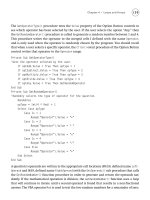Microsoft press 3d programming for windows jul 2007 ISBN 0735623945
Bạn đang xem bản rút gọn của tài liệu. Xem và tải ngay bản đầy đủ của tài liệu tại đây (4.57 MB, 837 trang )
3DProgrammingforWindows®:ThreeDimensionalGraphicsProgrammingforthe
WindowsPresentationFoundation
byCharlesPetzold
Publisher:MicrosoftPress
PubDate:July25,2007
PrintISBN-10:0-7356-2394-5
PrintISBN-13:978-0-7356-2394-1
Pages:448
TableofContents|Index
Overview
TheWindowsPresentationFoundationisakeycomponentof
.NETFramework3.0,whichisapartofWindowsVistaand
availableforWindowsXP.WiththeWindowsPresentation
Foundation,3Dimagescanbedisplayedregardlessofthe
video-displayhardwareontheusersmachine.Focusingon
developinguserinterfaceobjectsorsimpleanimations,this
bookbuildsonareadersknowledgeofWindowsPresentation
Foundationessentialstodemonstratehowtoeffectivelycreate
3DgraphicsforWindows.Yougetthefundamentalinformation
forusingtheWindowsPresentationFoundation3Dapplication
programminginterface(API),aswellasin-depthcoverageof
meshgeometries.
3DProgrammingforWindows®:ThreeDimensionalGraphicsProgrammingforthe
WindowsPresentationFoundation
byCharlesPetzold
Publisher:MicrosoftPress
PubDate:July25,2007
PrintISBN-10:0-7356-2394-5
PrintISBN-13:978-0-7356-2394-1
Pages:448
TableofContents|Index
Copyright
Introduction
Chapter1.Lights!Camera!MeshGeometries!
Three-DimensionalCoordinates
PointsinSpace
IntroductiontoVectors
Definingthe3DFigure
LightsandCamera
TheViewport3DandItsConstituents
VariationsinCodeandMarkup
FieldsofView
DefiningFlatRectangles
Defining"Solid"Figures
BalancingLightSources
TheOrthographicProjection
WhyNotSharetheVertices?
Transparency
SortingOuttheClasses
Chapter2.TransformsandAnimation
AnimationWithoutTransforms
ManipulatingCollections
TheTransform3DClass
TheTranslationTransform
ShareableModels
TheScaleTransform
CombiningTranslationandScaling
HowtoBuildaChair
Chapter3.Axis/AngleRotation
TheRotationTransform
CombiningRotationandOtherTransforms
IntroductiontoHit-Testing
AnimatingtheAxis
Chapter4.LightandShading
LessonsinIllumination
VectorMathematics
DiffuseMaterialandItsProperties
SpotLightandPointLight
Chapter5.TextureandMaterials
GradientBrushes
TileBrushes
SpecularandEmissiveMaterials
Chapter6.AlgorithmicMeshGeometries
TriangulationBasics
TriangulationResources
DerivingfromModelVisual3D
ThePetzold.Media3DLibrary
Chapter7.MatrixTransforms
LinearTransforms
AffineTransformsandBeyond
CameraTransforms
Chapter8.Quaternions
TheConvenienceofComplexNumbers
HamiltonandQuaternions
WhyAreQuaternionsSoWeird?
TheQuaternionStructure
QuaternionsandRotation
Low-LevelQuaternionRotation
QuaternionsandRotationMatrices
SLERPandAnimation
Chapter9.ApplicationsandCuriosa
ControlTemplates
3DVisualizationofData
MimickingRealWorldObjects
InteractiveMouseTracking
Printingin3D
Anaglyphs
AbouttheAuthor
AdditionalResourcesforDevelopers
VisualBasic2005
VisualC#2005
WebDevelopment
DataAccess
SQLServer2005
OtherDeveloperTopics
MoreGreatDeveloperResources
DeveloperStepbyStep
DeveloperReference
AdvancedTopics
Index
Copyright
PUBLISHEDBY
MicrosoftPress
ADivisionofMicrosoftCorporation
OneMicrosoftWay
Redmond,Washington98052-6399
Copyright©2008byCharlesPetzold
Allrightsreserved.Nopartofthecontentsofthisbookmaybe
reproducedortransmittedinanyformorbyanymeanswithout
thewrittenpermissionofthepublisher.
LibraryofCongressControlNumber:2007928771
PrintedandboundintheUnitedStatesofAmerica.
123456789QWT210987
DistributedinCanadabyH.B.FennandCompanyLtd.
ACIPcataloguerecordforthisbookisavailablefromtheBritish
Library.
MicrosoftPressbooksareavailablethroughbooksellersand
distributorsworldwide.Forfurtherinformationabout
internationaleditions,contactyourlocalMicrosoftCorporation
officeorcontactMicrosoftPressInternationaldirectlyatfax
(425)936-7329.VisitourWebsiteat
www.microsoft.com/mspress.Sendcommentsto
Microsoft,MicrosoftPress,DirectX,IntelliSense,Internet
Explorer,VisualStudio,Win32,Windows,andWindowsVista
areeitherregisteredtrademarksortrademarksofMicrosoft
CorporationintheUnitedStatesand/orothercountries.Other
productandcompanynamesmentionedhereinmaybethe
trademarksoftheirrespectiveowners.
Theexamplecompanies,organizations,products,domain
names,e-mailaddresses,logos,people,places,andevents
depictedhereinarefictitious.Noassociationwithanyreal
company,organization,product,domainname,e-mailaddress,
logo,person,place,oreventisintendedorshouldbeinferred.
Thisbookexpressestheauthor'sviewsandopinions.The
informationcontainedinthisbookisprovidedwithoutany
express,statutory,orimpliedwarranties.Neithertheauthors,
MicrosoftCorporation,noritsresellers,ordistributorswillbe
heldliableforanydamagescausedorallegedtobecaused
eitherdirectlyorindirectlybythisbook.
AcquisitionsEditor:BenRyan
ProjectEditor:ValerieWoolley
TechnicalEditor:TechnicalReviewer:KennScribner;TechnicalReviewse
ContentMaster,amemberofCMGroup,Ltd.
EditorialandProductionServices:Publishing.com
BodyPartNo.X13-82451
Introduction
MicrosoftWindowsVistaisthefirstversionofWindowstohave
built-insupportforthree-dimensionalgraphics.This3D
graphicssupportisintegratedwiththeMicrosoftWindows
PresentationFoundation(WPF),theclientapplication
programminginterface(API)thatwasintroducedin2006as
partoftheMicrosoft.NETFramework3.0.Although.NET3.0is
automaticallyincludedinWindowsVista,youcanalsoinstallit
underMicrosoftWindowsXPwithServicePack2orWindows
Server2003withServicePack1.
Thisbookshowsyouhowtowriteprogramstargetingthe3D
graphicsAPIoftheWindowsPresentationFoundation—or"WPF
3D,"asitisknowntoitsfriends.Thisbookisessentiallya
comprehensiveexaminationofvirtuallyalltheclassesand
structuresinthe.NETnamespace
System.Windows.Media.Media3D,withplentyofcodeand
markupexamples.
TheRoleofWPF3D
WPF3Disnotintendedforgraphics-intensivepoint-of-view
games;norisitsuitableforproducingthenextbig-screenepic
featuringthree-dimensionalrodentsorogres.Programmers
whowanttopursuethosetypesofapplicationsmightbe
happierlookingatMicrosoftDirectXratherthanWPF3D.
WPF3Disinsteadintendedtogiveprogrammerstheabilityto
integrate3DintotheirclientWindowsapplications.Thisuseof
enhancedgraphicsmightbeassubtleasfashioningacontrol
thathasa3Dappearance,orusing3Dtodisplaycomplex
information,ormimickingreal-worldobjects(suchasbooks).
ThelastchapterofthisbookhassomeexamplesofWPF
applicationsincorporating3DthatIhopewillinspireyou.
AlthoughWPF3Disnotintendedforcomplexgamesormovies,
itisdefinitelybuiltforanimation.WPFincludesanextensive
animationAPIandyoucanusethatAPIwithyour3Dgraphics.
InthisbookIbegindemonstratinganimationinChapter2,
"TransformsandAnimation,"andIneverletup.Somewhat
relatedtoanimationisdatabinding.Youcanmoveortransform
3Dfiguresbybindingthemtocontrolssuchasscrollbars—
anotherofmyfavoriteactivitiesinthisbook.
AlthoughWPF3DrunsonbothWindowsVistaandWindowsXP
with.NET3.0installed,youdon'tgetexactlythesamefeatures.
EvenonWindowsVista,thequalityof3Dgraphicsisdependent
onthevideoboardyouhaveinstalledinthecomputer.Avideo
boardwithabetteron-boardgraphicsprocessingunit(GPU)
canaccomplishsomefeatsthataretooslowtobedoneentirely
insoftware.WPFgraphicscapabilitiesarecategorizedby"tiers"
thataredescribedonthisWebpage:
/>Inparticular,onlywithaTier2videoboardinstalledunder
WindowsVistadoyougetanti-aliasingin3D.(Anti-aliasingis
theuseofshadesofcolortominimizethestark"staircase"
effectcausedbyusingdiscretepixelstorepresentcontinuous
linesorsurfaces.)Inthegrandschemeofthings,anti-aliasing
mightnotsoundlikeanimportantfeature,butitmakesabig
differencewhen3Dgraphicsareanimated.
Youmightwanttogetanewvideoboardforyourforaysinto
3Dgraphics,butifyou'rewritingapplicationsforotherusers,
youmightalsowanttobeawareofthelimitationsthatsomeof
yourusersmayexperiencewhentheyrunyourprograms.
YourBackground
Inwritingthisbook,Ihaveassumedthatyoualreadyhave
experienceprogrammingfortheWindowsPresentation
FoundationusingtheC#programminglanguageandthe
ExtensibleApplicationMarkupLanguage(XAML)thatwas
introducedaspartof.NET3.0.
Ifyou'reabeginningprogrammer,Irecommendthatyoulearn
C#firstbywritingconsoleprograms,whicharecharacter-mode
programsthatrunintheCommandPromptwindow.Mybook
ProgrammingintheKeyofC#:APrimerforAspiring
Programmers(MicrosoftPress,2003)takesthisapproach.
Ifyou'reaprogrammerwhohasapreviousbackgroundinCor
C++buthasnotyetlearnedaboutprogrammingforthe.NET
FrameworkwithC#,youmightwanttobeginwithmyshort
book.NETBookZero:WhattheCorC++ProgrammerNeeds
toKnowAboutC#andthe.NETFramework.Thebookisfree
andisavailableforreadingordownloadingfromthefollowing
pageofmyWebsite:
/>Ifyou'refamiliarwithearliermanifestationsof.NETbuthaven't
yettackled.NET3.0,WPF,andXAML,mybookApplications=
Code+Markup:AGuidetotheMicrosoftWindowsPresentation
Foundation(MicrosoftPress,2006)isacomprehensivetutorial.
SeveralaspectsofWPFprogrammingaremorecrucialfor3D
thanothers.Theseare:
XAMLsyntax,includingdatabindingandresources.
Dependencyproperties.
Animationandstoryboards.
Two-dimensionalbrushes.
IfyouareanexperiencedWPFprogrammerbutyoupreferto
codeinMicrosoftVisualBasic.NEToranother.NET-compliant
language,Icanonlytellyouthatmanyoftheprogramming
examplesinthisbookareinXAMLratherthanC#.Learningat
leasttoreadC#codeandmentallytranslateitintoyour
preferredlanguagehasbecomeavitalskillin.NET
programming.
Three-dimensionalgraphicsprogrammingnecessarilyinvolves
mathematics,butI'vetriedtopresumeaminimumof
backgroundknowledge.Forexample,I'veprovidedrefreshers
onvectors,matrixalgebra,andimaginarynumbers,butI've
assumedthatyouhavenopreviousknowledgeofquaternions.
However,Idowantyoutocometothisbookwithabasic
facilitywithtrigonometry.Idon'tneedyoutoreelofflistsof
commontrigonometricidentities,butyoushouldhaveagood
workingknowledgeofangles,radians,sines,cosines,and
tangents.Ifyouknowwithoutthinkingtoohardthatthereareπ
radiansin180degrees,thatthesineof90degreesequals1,
thatthecosineofzerodegreesalsoequals1,andthatthe
tangentof45degreesequals1aswell,youshouldbeingood
shape.
SomeoftheWPF3Dclassesarespecificallyintendedtoinsulate
youfromheaviermathematicsgoingonunderthecovers.
Consequently,Icoverthoseclassesearlyinthebook.Notuntil
relativelylateinthebookdoIgetintothemoremathematicsladentopicsofmatrixtransformsandquaternions.Depending
onyourambitionsandaspirationsregarding3Dgraphics
programming,youmightfindthesechapterschallengingor
altogethertooscary.Booksaregreatforconflictslikethat
because:
Youcanskipsomethingifyoudon'twanttobotherwithit
justnow.
Youcancomebackandreadsomethinglater—perhaps
morethanonce.
Myobjectiveistohelpyou,nottortureyou.
SystemRequirements
Tocompileandruntheprogramsdescribedinthisbook,you'll
need:
WindowsVista,WindowsXPwithServicePack2,or
WindowsServer2003withServicePack1.
The.NETFramework3.0.Thisisincludedaspartof
WindowsVista;forWindowsXPorWindowsServer2003
youcandownloadithere:
/>familyid=10CC340B-F857-4A14-83F5-25634C3BF043
The.NETFramework3.0SoftwareDevelopmentKit(SDK),
availableasaDVDimagehere:
/>familyid=7614FE22-8A64-4DFB-AA0C-DB53035F40A0
orasaWebinstallhere:
/>familyid=C2B1E300-F358-4523-B479-F53D234CDCCF
MicrosoftVisualStudio2005StandardEditionor
ProfessionalEdition.
VisualStudioExtensionsfor.NET3.0,availablehere:
/>familyid=F54F5537-CC86-4BF5-AE44-F5A1E805680D
Intheory,youdon'tneedVisualStudiotocompileandrunWPF
applications.The.NETFramework3.0SDKincludesa
command-lineprogramnamedMSBuildthatbuildsWPF
applicationsfromC#project(.csproj)files.However,Visual
StudiocertainlymakesWPFdevelopmenteasier.
ThevariouslinksI'velistedfordownloadingthe.NET
Framework,theSDK,andtheVisualStudioextensionsareall
directlyaccessiblefromthe3DpageofmyWebsite:
/>Gototheheading"UsingtheBook."Underthatheadingyou'll
alsofindalinktoanEmptyProjectfileforusewithVisual
Studio2005,whichisanapproachtoWPFprogrammingthatI
prefer.(Infact,writingyourowncoderatherthanlettingVisual
Studiogeneratecodeforyouissometimesknownas"Petzold
style.")
Atthetimeofthiswriting,thenextversionofVisualStudio
(currentlycode-namedOrcas)isavailableinabetaversion.
Orcasincorporatesthe.NETFramework3.5andthe.NET
Framework3.5SDK,anddoesnotrequireany"extensions."As
Orcasbecomesmorewidelyavailable,I'llhaveinformation
aboutusingitonthe3DpageofmyWebsite.
ForwritingandexperimentingwithstandaloneXAMLfiles,you
canuseXAMLPad,whichisincludedwiththeSDK,ormyown
XamlCruncher,whichyoucaninstallfromtheWPFpageofmy
Website:
/>Inparticular,XamlCruncher2.0letsyouloadDLLfilesintothe
applicationdomain.ThesefilesarethenaccessibletotheXAML
fileyou'redeveloping.
CodeSamples
Allthecodesamplesshowninthisbook(andsomethatare
mentionedbutnotshowninthesepages)canbedownloaded
fromthebook'scompanioncontentpagemaintainedby
MicrosoftPressatthefollowingWebsite:
/>Purchaseofthisbookgivesyouaroyalty-freelicensetouseany
codesamples(ormodifiedcodesamples)youmightfinduseful
inyourownprograms,includingcommercialsoftware.(That's
oneofthepurposesofthisbook.)However,youcannot
republishthecodesamples.(That'swhythey'recopyrighted.)
ObviouslyIcan'tguaranteethatthesourcecodeisapplicable
forspecificpurposesoreventhatitworksright.(That'swhyit's
free.)
Ifyoupagethroughthisbook,you'llnoticethatithasanumber
ofpictures.Someoftheseare"screenshots"takenofthe
samplecoderunningunderWindowsVista.Butothersare
diagramsandfiguresthathelpexplaintheconceptsI'm
discussing.Alltheseotherdiagramsandfigureswerecreated
withXAMLfiles.ThenameoftheparticularXAMLfileis
indicatedinitalicsundereachofthesefigures.Youcanfind
theseXAMLfilesintheFiguresdirectoryofthedownloadable
code.RunningsomeoftheseXAMLfilesrequiresloadingthe
Petzold.Media3Dlibrary(whichI'lldescribeshortly)into
XamlCruncher2.0.
Petzold.Media3DandOtherTools
Thedownloadablecodeforthisbookalsoincludessourcecode
foradynamic-linklibrarynamedPetzold.Media3D.dllthat
containssomeclassesthatmightbehelpfulinyour3D
programming.Ifyou'rerunningXamlCruncher2.0,youcanload
thisDLLintotheprogram'sapplicationdomainandaccessit
fromXAMLfilesthatyoucreate.
MorerecentversionsofthePetzold.Media3Dlibraryare
availablefordownloadingfromthe3DpageofmyWebsite:
/>Purchaseofthisbookgivesyouaroyalty-freelicensetoinclude
thisDLLwithyourownprograms,includingcommercial
software.Youcanalsouseanyofthesourcecode(including
modifiedversionsofthesourcecode)incompilationsofyour
ownprograms.However,Irequestthatyoudonotdistribute
modifiedversionsofthelibraryitself.Ifyou'dliketoenhance
thelibraryinsomeway,dosobyderivingfromtheclassesin
thelibrary.Ialsoaskthatyoudonotdistributeanyofthe
sourcecodethatcontributestothislibrary,eitherinamodified
orunmodifiedstate.
ThePetzold.Media3DlibraryisonlyoneofseveralWPF3D
librariesavailabletotheprogrammer.Inparticular,theWPF3D
teamatMicrosofthasputtogethera3DToolslibraryavailable
here:
/>TheWPF3Dteammaintainsablogthatoftencontainsessential
informationhere:
/>
SupportforThisBook
Everyefforthasbeenmadetoensuretheaccuracyofthisbook
andthecompanioncontent.Ascorrectionsorchangesare
collected,theywillbeaddedtoaMicrosoftKnowledgeBase
article.
MicrosoftPressprovidessupportforbooksandcompanion
contentatthefollowingWebsite:
/>
QuestionsandComments
Ifyouhavecomments,questions,orideasregardingthisbook
orthecompanioncontent,orifyouhavequestionsthatarenot
answeredbyvisitingthesitespreviouslymentioned,please
sendthemtoMicrosoftPressviae-mailat:
orviapostalmailat:
MicrosoftPressAttn:3DProgrammingforWindowsEditor
OneMicrosoftWay
Redmond,WA98052-6399
PleasenotethatMicrosoftsoftwareproductsupportisnot
offeredthroughtheseaddresses.
Author'sWebSite
Informationspecifictothisbookcanbefoundonthispageof
myWebsite:
/>Informationaboutmyotherbooks,aswellasablogand
miscellaneousarticles,canbeaccessedfromthehomepageof
myWebsite.
SpecialThanks
GraphicsprogramminginWindowshasalwaysespecially
appealedtome.Inyearsgoneby,Ibeganwritingbooksabout
Windowsgraphicsprogramming—andevenoneaboutgraphics
programmingfortheOS/2PresentationManager—but
somethingelsealwayscameupandthesebookswerenever
completed.(Twocoversoftheseabandonedbookscanbeseen
atthebottomoftheBookspageofmyWebsite.)
Theprospectofwritingabookabout3Dgraphicsprogramming
forWindowswasveryexciting.AfterIbeggedtowritethis
book,myagentClaudetteMooreandMicrosoftPress
AcquisitionsEditorBenRyanhelpedmakeitreality.Thankyou
verymuch!
ApparentlyProjectEditorValerieWoolleyandTechnicalEditor
KennScribnerweresufficientlyrecoveredfromtheexperience
ofworkingwithmeonApplications=Code+Markupthatwe
wereabletoreunitethe"team"forthisbook.Iamvery
thankfulfortheirtirelessworktohelpmakethisabookwecan
holdupwithpride.
Positionedatthevanguardintheconstantbattletoprevent
civilizationfromdegeneratingintochaosandbrutalityarecopy
editors.TheyhelpkeeptheEnglishlanguagecleanfromthe
evilsofsplitinfinitives,danglingparticiples,mismatchedtenses,
andthepassivevoice.Iamforevergratefultothediligenceof
mycopyeditorBeckaMcKayinfixingmyproseandhelpingme
writewithasmuchclarityaspossible.
EricSinkandLarrySmithgraciouslyvolunteeredtoreadraw
draftsofthisbook,andIamfortunatetheydidnotalsoaskme
topayforthepsychiatriccounselingundoubtedlyvitaltotheir
recoveryfromtheexperience.Theirfeedbackandtypodetectionskillswereinvaluable.
MyfriendsatMicrosoftcontinuetobegenerouswiththeir
knowledgeandwisdom.Fromthe3DteamIthankDaniel
Lehenbauer,JordanParker,AdamSmith,GregSchechter,and
PeterAntal.Ihavealsobenefitedgreatlyfromthe
encouragementofStephenToub,PabloFernicola,TimSneath,
andPaulScholz.
Ine-mailsandblogentries,LarryO'Brien,RobHill,andNathan
Dunlaphavegivenmeadviceandlessons.Theinspirationfor
theStatePopulationAnimatorprogramcamefromadiscussion
withNeilDevadasan.
And,ofcourse,verymuchloveandthanksgotoDeirdre,who
hashelpedmakethepastdecadetheverybestyearsofmylife.
CharlesPetzold
NewYorkCityandRoscoe,NewYork
December2006–June2007
Chapter1.Lights!Camera!Mesh
Geometries!
Inthischapter:
Three-DimensionalCoordinates
8
PointsinSpace
9
IntroductiontoVectors
11
Definingthe3DFigure
15
LightsandCamera
19
TheViewport3DandItsConstituents
22
VariationsinCodeandMarkup
25
FieldsofView
29
DefiningFlatRectangles
33
Defining"Solid"Figures
37
BalancingLightSources
39
TheOrthographicProjection
43
WhyNotSharetheVertices?
46
Transparency
48
SortingOuttheClasses
50
EversinceartistsoftheUpperPaleolithicerabeganadorning
cavewallswithimagesofhuntersandtheirprey,peoplehave
strivedtodepictthree-dimensional,real-worldobjectsontwodimensionalsurfaces.Ournewspapers,magazines,books,
museums,scratchpads,photoalbums,movietheatres,video
libraries,andcomputersarefilledwiththeresults.
Humanperceptionissoattunedtothethreedimensionsofthe
realworldthatweareeasilypersuadedtoacceptevensimple
drawingsasrepresentingactualobjects.This,forexample,is
obviouslyjustageometriccircle:
Circle.xaml
Butaddalittleshading,anditbecomesaball:
Ball.xaml
Youdon'tneedany3Dprogrammingtodisplaysuchaball:The
interiorofacircleissimplycoloredwithaRadialGradientBrush.
Thecolorvariesfromredontheedges(renderedasgrayonthe
page)towhiteatthepointspecifiedbytheGradientOrigin
property.SettheGradientOriginoff-centertosuggestalight
sourcefromtheupperleft,whichhasbecomeaconventionin
on-screencomputergraphics.
Thefollowingobjectisdepictedsolelybyitsedges,andyetitis
easilyrecognizable:
SolidCube.xaml
Althoughwecan'tseetheentireobject,onlyextremeskeptics
wouldsuggestthatthebackpartoftheobjectismuchdifferent
fromthefront.Analternativeversionoftheclassiccubeshows
alltheedges:
HollowCube.xaml
Oureyesandbrainstillwanttoseethisasacube,butthey
can'tdecidewithanyassurancewhichsideisintheforeground
andwhichisinthebackground.Rationallywecanacknowledge
thatthefigureismerelytwosquareswiththeircorners
connected,butthisinformationbarelyaffectswhatweclearly
perceive.
Wesomuchwanttoseethree-dimensionalobjectsinsimple
drawingsthatevensomethingasimpossibleasthisobject
seemsoddlyreal:
DevilsPitchfork.xaml
ThatmonstrosityissometimesknownastheDevil'sPitchfork,
andforgoodreason.I'veoftenbeentemptedtotrytobuild
suchanobject,andthere'salwayspartofmynon-rationalbrain
thatinsistsitcanbedone.
AsculptureinEastPerth,Australia,hasmanagedtomimicthe
famoustrianglenamedaftermathematicianRogerPenrosebut
devisedearlierbySwedishartistOscarReutersvärd:
PenroseTriangle.xaml
ThatAustraliansculptureonlyseemstoachievethisimpossible
designwhenviewedfromtwospecificlocations.Other
impossiblestructurescanbefoundintheworksofDutch
graphicartistM.C.Escher,whosetoyingswiththeconventions
oftwo-dimensionalrepresentationsofthree-dimensionalfigures
havedelightedprogrammersandothertechiesformany
decades.
Whatisthisfigure?
OrthographicSquareCuboidOutline.xaml
Mathematicianswouldrecognizeitasasquarecuboid.Acuboid
isasolidwithsixrectangularfacesthatjoinatrightangles,
whereoppositesidesareequalindimension.Iftwoofthese
oppositesidesaresquare,thefigureisasquarecuboid.Ifall
sixsidesaresquare,thefigureissimplyacube.
Now,whatisthisfigure?
PerspectiveSquareCuboidOutline.xaml
Thetemptationistosaythatthisisalsoasquarecuboid,
becausethatisprobablythesimplestexplanation.Infact,this
isactuallyamorerealisticviewofasquarecuboidthanthefirst
rendition.Aseveryoneknows,objectsfartherfromtheeyelook
smaller,aphenomenonknownasforeshorteningorperspective.
Inreallife,thesquareatthefarendoftheobjectwouldappear
smallerthanthesquareintheforeground.
Theclassificationofthesecondlongobjectasasquarecuboid
certainlydoesn'tnegatetheearlierverdictonthefirstobject.
It'sjusttwodifferentwaysofrepresentingthree-dimensional
figuresonflatsurfaces.Inmathematicstextbooksor
engineeringdrawings,theversionwithoutperspectivewould
surelybeconsideredpreferable.(Ofcourse,youhaveto
maintainacertainamountoftrustthatyouaren'tbeing
deliberatelydeceived:thefirstofthetwofiguresmighthavea
largerbackendreducedinsizebyaperspectiverendition,while
thesecondobjectcouldreallyhaveasmallerbackend.)
Anymethodtorenderathree-dimensionalfigure—beitreal,
imaginary,orhypothetical—onatwo-dimensionalsurfaceis
knownasaprojection.Thefirstsquarecuboidwasrendered
withatypeofprojectionknownasorthographicprojection,
fromtheGreekwordorthosforstraight.(Hence,orthogonal
meansperpendicular,orthodonticsmeansstraightteeth,
orthopedicsmeansstraightlegs,andorthodoxymeans"straight
beliefs.")Thefigureisprojectedontoaviewingplaneby
imaginarylinesthatarerightanglestotheplane:
OrthographicProjection.xaml
Somedistortionmightbepresent—inthiscasethetotalheight
ofthefigureisnotrepresentedbytheprojection—butthemost
importantcharacteristicoftheorthographicprojectionisthe
preservationofparallellines.Linesthatareparallelinreallife
areparallelontheprojection.Ofcourse,theviewofthethreedimensionalobjectisdifferentdependingonthelocationofthe
projectionplane.Technicaldrawingsgenerallyuseseveral
orthographicprojectionstoshowviewsofanobjectfrom
severalsides.Orthographicprojectionsonparallelplanesare
identical.
Incontrasttoorthographicprojectionisperspectiveprojection,
whichisbasedontheworkingsofthehumaneye.Theeyeisa
complicatedmechanism,ofcourse,butforourpurposesmight
beapproximatedbyapinholecamera.Inapinholecamera,all
thelightfromafigurecomesthroughatinyholeandstrikesa
planesurface,ontowhichthefigureisprojectedupsidedown.
VisualProjection.xaml
Thelightrayspassingthroughthepinholedonotstrikethe
planeatuniformanglesastheydointheorthographic
perspective.Lightraysfromobjectsthatarefartherfromthe
pinhole(suchasthetwoprojectionlinesatthetopofthis
figure)comethroughthepinholeatamoreacuteangletoeach
otherthanforobjectsclosertothepinhole,resultinginthe
familiarforeshorteningeffect.
Thehumaneyeandaregularcameraworkmuchlikeapinhole
camera,exceptthatthepinholeisreplacedwithalens.By
refractingraysoflighttowardafocalpoint,thelensprovidesa
largeraperturethanapinholeandallowsmorelighttogetin.
Thedownsideisthatthelenscannotfocusalldistancesequally.
Butthisisn'tquiterelevantforthediscussion.
Asyoumovetheprojectionplaneclosertothepinhole,the
imagegetssmaller,andasyoumoveitfartheraway,theimage
getslarger.Buttheproportionsamongpartsoftheimage
remainthesame.However,ifyoumovethepinholecloserto
theobject,theprojectedfrontoftheobjectgetslargerin
relationtotheback,andperspectiveisexaggerated.Ifyoupull
thepinholefartherback,thedifferenceinsizebetweenthe
foregroundandbackgrounddecreases.
Inthehumaneyeandthecamera,theimageontheplaneis
upsidedown.Partiallytoavoidupside-downimagesindiagrams
suchasthese,theperspectiveprojectionisusuallydrawnlike
this:
PerspectiveProjection.xaml
Thepinholehasbeenreplacedwithafocalpoint,andthe
projectionplaneisnowbetweenthefocalpointandtheobject.
Butit'sreallythesamegeometry.Asyoumovetheprojection
planebetweenthefocalpointandtheobject,theprojected
imagegetslargerorsmaller,buttheproportionsremainthe
same.Movethefocalpointclosertotheobject,andthe
perspectiveisexaggerated.Movethefocalpointfartherback,
andtheperspectiveisdecreased.Ifyoumovethefocalpointto
infinity,theperspectiveprojectionbecomestheorthographic
projection.
TheMicrosoftWindowsPresentationFoundation(WPF)threedimensionalgraphicsclasslibrary(whichI'lloftenabbreviateas
WPF3D)performsallthemathematicsnecessarytoprojecta
three-dimensionalfigureontoatwo-dimensionalsurfacesuch
asacomputerscreenoraprinterpage.You,theprogrammer,
canselectthetypeofprojectionyouwantbychoosingoneof
theclassesthatderivefromtheabstractCameraclass.The
Cameraclassanditsderivatives,likealmostallWPF3Dclasses,
aredefinedinthe.NETnamespace
System.Windows.Media.Media3D.Thetwoclassesnamed
OrthographicCameraandPerspectiveCameraperformthe
necessarytransformationsfortheorthographicandperspective
projection.WPF3DalsoincludesaMatrixCameraclassfor
advancedpurposesthatcanperformarbitrarytypesof
projectionsofthree-dimensionalobjectsontotwo-dimensional
surfaces,butIwon'tbediscussingthatoptionuntilChapter7,
"MatrixTransforms."
Ofcourse,acameraisuselesswithoutsomethingtopointitat,
sousuallythefirststepincreatingathree-dimensionalscenein
WPF3Distodescribeafigureinthree-dimensionalspace.
Three-DimensionalCoordinates
WPF3Dusesatraditionalthree-dimensionalcoordinatesystem,
generallypicturedsomethinglikethis:
Axes.xaml
Thethreeaxesmeetatanorigin.IncreasingvaluesofXareto
theright;increasingvaluesofYareupward;increasingvalues
ofZcomeoutofthecomputerscreenandtowardtheviewer.
Thisisknownasaright-handcoordinatesystem:Ifyoupoint
theforefingerofyourrighthandinthedirectionofincreasingX
valuesandthemiddlefingerpointstoincreasingYvalues,your
thumbpointstoincreasingZvalues.
Isaidthatthediagramshowshowthecoordinatesystemis
"generallypictured"becauseitreallydependsonhowyouview
it.Youcouldviewitfromalldifferentdirections.Indeed,ifI
orientedthediagramsothattheZaxispointedexactlytoward
theviewer,theaxiswouldbevisibleonlyasapoint.The
importanceoftheright-handruleisthis:Basedonthedirection
ofanytwoaxes,youcanalwaystellhowthethirdisoriented
byapplyingtherule.
Justasthetwoaxesofthetraditionaltwo-dimensional
Cartesiancoordinatesystemdividetheplaneintofour
quadrants,threeplanesinthethree-dimensionalcoordinate









